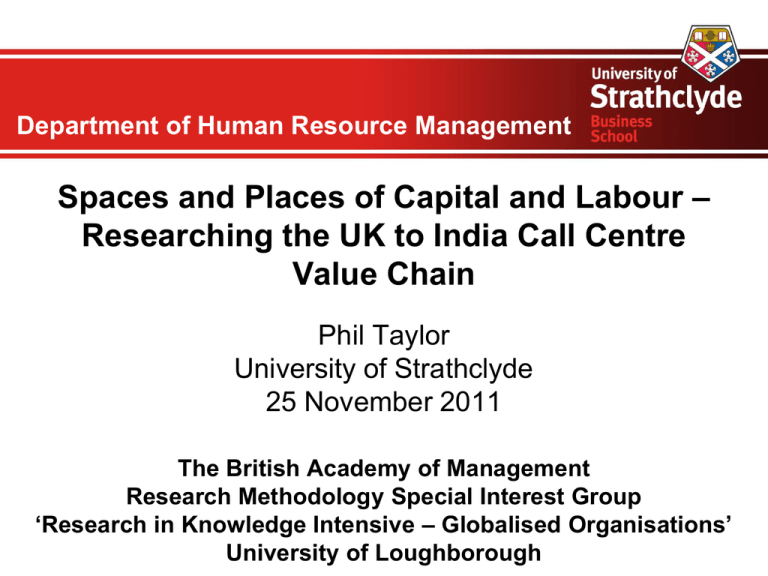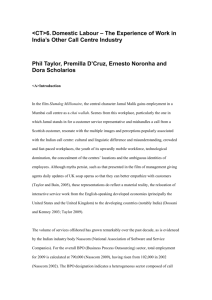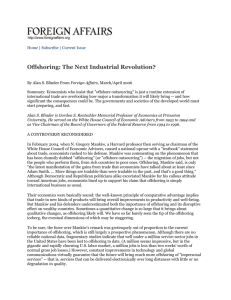Phill Taylor Slides - British Academy of Management
advertisement

Department of Human Resource Management Spaces and Places of Capital and Labour – Researching the UK to India Call Centre Value Chain Phil Taylor University of Strathclyde 25 November 2011 The British Academy of Management Research Methodology Special Interest Group ‘Research in Knowledge Intensive – Globalised Organisations’ University of Loughborough Department of Human Resource Management Introduction • Title is not a throwaway nor rhetorical, but considered • Customers in developed economies interacting with servicing agents in particular developing countries • But the call centre value chain is not a de-materialised abstraction – critique of weightlessness (Huws, 2003) • The c.c. chain (or network?) is not ‘virtual’ but tangible • Across space – digital ICTs, optic fibre cabling, investment flows, managers, transition teams, lift & shift • Capital and technology are more mobile than labour, which is essentially place-bound (Castree et al, 2004: 69ff) • Differential characteristics of labour in place - or respective places – generate research problematics Department of Human Resource Management • ‘Spatial fix’ (Harvey,1982) – capital accumulation strategies develop global reach but capital must materialise somewhere • Firm primary actor - directly or subsidiaries or contractors degrees of disaggregation – organises production • We might apply the spatial fix metaphor to research practice between places - diversity of research norms/expectations - differential access issues - the legacy of historical and cultural traditions and reflexivity (**academic equivalent of East India Company Mark II**) - comparative study – validation, replication, generalisation - assumptions, traditions, orientations of researcher his/herself, themselves - legacy of researchers’ previous studies – theory building Department of Human Resource Management Call Centre/BPO Research – From the National to the Transnational • From 2002-2011 rolling projects focused on offshored and outsourced call centres and BPO • Prefigured by 7 years research on Scottish/UK c.c.s • UK projects generated problematics, amplified or given unique cultural twists when refracted through Indian lens • CC as relatively new phenomenon in 1990s – scale, sector, workforce characteristics, contract etc.= political economy + management practices and work organisation • Scottish Enterprise and CCA support – govt. and employer endorsement – objective ‘facts’ but good news • How to reconcile with the critical sociological, I.R., labour process, TU organising interests of Taylor and Bain? Department of Human Resource Management • • • How to sustain employer access while drilling deep into and revealing employee experience? Genuinely critical work likely to lead to closed doors ‘An assembly line in the head’ – work and employee relations in the call centre’ (Taylor and Bain, 1999) – employers’ responses mixed • ‘High wire act’ - helped by reports that informed employers • Trade union access and worker confidence were never problems in the UK e.g. ‘Subterranean Worksick Blues’ Researching offshoring and cc chain brought new challenges to this carefully constructed edifice UK and Indian employers super-sensitive, Indian labour in different place with contrasting expectations • • Department of Human Resource Management How to Research Global Call Centre? – Methodological Limitations of GCCP • Global Call Centre Project (GCCP) (Holman et al, 2007) • Extensive data on management and employment practices from 2,500 centres across 17 countries • Same questionnaire in each country • GCCP informed by the ‘Varieties of Capital’ e.g. (Hall and Soskice, 2001) – national institutional distinctions • National contrasts/comparisons– LME, CME, transitional • Important to know market and organisational convergence • Divergent work organisational, HR and IR practices • But GCCP not so much a ‘globalised’ study as comparative of nationally aggregated data sets Department of Human Resource Management • GCCP deals inadequately with offshoring phenomenon, failing to account for:- drivers of uneven capital and technology transnational flows locational strategies and reasons transformative role of TNCs the emergent global divisions of labour implications of the dependency of international-facing c.c.s on corporate decisions in developed countries not drawn out co-ordination across the transnational servicing chain understanding of India’s (and industry’s) distinctive history, culture, managerial practice labour and indeterminacy take different forms in India cannot be read off from universal template hugely significant for the practice of research Department of Human Resource Management Alternatives - Researching the CC Chain • • Context – 2002 first wave of UK offshoring to India Research questions included:- What is current scale of offshoring? What are the factors driving, inhibiting, facilitating offshoring, considered from Indian and UK perspectives? What were the type of services being offshored? What was the scale of UK job loss and future job loss? What were growth prospects for Indian BPO/cc industry? What were the features of work organisation, labour process and HRM policy and practice in India? In what ways were Indian characteristics comparable to and contrasted with those from Scotland/UK? • Underpinning– explanation and plausible generative mechanisms Department of Human Resource Management Philosophical Approach and Methods • Broadly critical realist, challenging the stereotypical oppositions and packaging of – positivism, objectivity and quantitative methods constructivism/interpretivism, subjectivity and qualitative methods • Reject the privileging of the epistemological over the ontological - albeit epistemological issues important • Complex causal processes in different contingent contexts that can plausibly account for events observed • As knowledge is bound up with conceptions – fallibility • But better or worse forms of knowledge do exist and reliable procedures for producing knowledge of things (Ackroyd and Fleetwood, 2004) Department of Human Resource Management • • • Methods are tools for tasks - no data source privileged Analytical generalisation primarily theoretical but bounded by the quantity and quality of the data Synthesise data from UK/Scotland and India from the contrasting nodes of the cc servicing ‘chain’, from source and destination countries understand how the cc activity tends ‘to slice through, while still being unevenly contained within state boundaries’ (Henderson et al, 2002) countries not bounded silos spatial division of labour and importance of place identical methods cannot be replicated in each place Department of Human Resource Management Capital - Researching the UK Organisation • Survey/audit to all centres in Scotland - SE sponsored • Completed by site management but for offshoring firms typically senior management based in London in FS • Practices and intentions of companies re. offshoring • Confidentiality and sensitivities – critical press and apocalyptic predictions • Audits and confidence in previous surveys (Taylor and Bain, 1997; 2000) re-assured companies • Documentary evidence and critical triangulation - TU sources e.g. Prudential, HSBC, Aviva, BTand DTI (2004) • Problem of ‘independence’ e.g. BBC documentary • UK/Scottish perspective on the ‘chain’ Department of Human Resource Management Disaggregated Organisations? Department of Human Resource Management Capital – Researching the Indian Organisation • • • • • • • Variable contractual relationship between UK firm and Indian supplier - from ‘captive’ to full ‘outsourcing’ Challenge of getting reliable data from Indian companies and market - confidentiality Objective – follow the links in the chain from ‘source to destination’ – in-house more difficult than third-party In-house ‘captives’ – e.g. HSBC, AXA Third-parties – e.g. Aviva ► EXL; BT ► Progeon Problematic of confidentiality and reliability of data from site visits and interviews – costs and attrition Concern that researcher has hostile agenda – would management reveal weaknesses? Department of Human Resource Management • • • Data from multiple sources– semi-structured interviews National Association of Software and Service Companies (Nasscom) annual and special reports Nasscom Conferences invaluable – attended every Leadership and BPO conference since 2003 presentations and debates on BPO industry – transcribed documentation and media informal discussions and networking – ‘wear the kilt’ serendipity and tacit knowledge based on immersion from feeling as an outsider to being an ‘insider’ (e.g. attrition rate on UK service was 84% in 2010) longitudinal dimension to the research – subtle shifts e.g. re-shoring of voice services to UK • ‘The subtleties a spectrograph would miss’ (Brian Eno) Department of Human Resource Management Department of Human Resource Management Researching Labour in India • • • • • • How to gain access to workers – a major issue Difficulties of gaining access through companies Initial approach – serendipity – sons and daughters of interviewees ►►►snowballing e.g. Windsor Tavern in Bangalore, in houses, coffee shops, hotels, Qualis From outsider to more or less accepted insider UNITES pro facilitated a more systematic approach Assumptions and preconceptions from experience of UK research challenged frequently sardonic attitudes towards management and co. HR seen in adversarial terms complaints about intensity of work and targets linguistic and cultural training Department of Human Resource Management Labour and Contrasting Globalisation Discourses In the Global ‘north’ - UK In the Global ‘south’ – India Pace and scale of offshoring causing Middle-class graduates keenly embrace well-paid employment intense anxiety Uncritical identification with Threat to jobs and union influence managerial demands Perceived ‘race to the bottom’ Resignation to job loss and inferior conditions and work intensification Strong professional identity Unrestrained competition between places damaging Powerful career identities Highly critical of company strategy Exclusivity towards unionisation HR and HR policy adversarial Unrestrained competition between places beneficial Captured ‘hearts and minds’ ‘Inclusivist’ HR perception Department of Human Resource Management Researching Union/Worker Responses to Globalisation in India • Not just that methods cannot be mechanically transposed • No established union – Unites an embryonic formation • Distribution of questionnaires (2007) – focused on workplace but cannot be distributed through workplaces • As an outsider – how to break through the shell? • Develop collaborative working with Indian academics but not East India Company Mark II • Utilise local networks ethically – unlike some • Responsiveness to context for survey e.g. travelling times, transportation, safety/security, working time • Example of cultural difference – women in cc workforce Department of Human Resource Management Some Tentative Conclusions • • • • • • Research and theory building is an incremental and iterative process – data partly independent of theory Significance of ‘reflexivity’ lies in this as much as in researcher-centric considerations Practice of research laden with difficulties in UK The Indian lens should force researchers to question assumptions in research practice and meaning of data The ‘substantive’ and methodological inextricably entwined Doesn’t mean explanatory logic is confined to narrative Department of Human Resource Management Department of Human Resource Management References Ackroyd, S. and Fleetwood, S. (eds.) (2004) Realist Perspectives on Management and Organisation, London: Routledge Castree, N., Coe, N., Ward, K. and Samers,M. (2004) Spaces of Work, London: Sage Hall, P. and Soskice, D. (eds.) Varieties of Capitalism – The Institutional Foundations of Comparative Advantage, Oxford: OUP Harvey, D. (1982) The Limits to Capital, London: Verso Henderson, G., Dicken, P., Hess, M., Coe, N. and Wa-Chung, H. (2002) ‘Global Production Networks and the Analysis of Economic Development’, Review of International Political Economy, 9.3: 436-64 Holman, D., Batt, R. and Holtgrewe, U. (2007) The Global Call Centre Report: International Perspectives on Management and Employment, Ithaca: Cornell University Huws, U. (2003) The Making of a Cybertariat, London: Merlin Department of Human Resource Management Taylor, P. (2010) ‘The globalization of service work: analysing the call centre value’, in Thompson, P. and Smith, C. Working Life: Renewing Labour Process Theory, pp. 244-268 Taylor, P. and Bain, P. (1999) ‘An assembly line in the head – work and employee relations in the call centre’, Industrial Relations Journal, 30.2: 101-117











